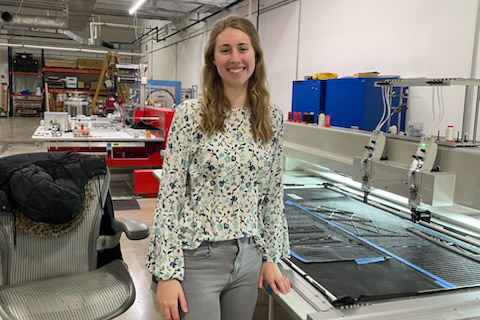Dayton Engineer

Mechanical engineering student uses quilting skills in research experience at UDRI
It’s not everyday that a student gets to combine their major and personal interest into a research opportunity.
But for Rachel Crossman, the opportunity came when she least expected it.
For Crossman, a mechanical engineering major with an aerospace concentration, attending UD and majoring in engineering was a natural choice for her future.
“When I was eight, we went to the Kennedy Space Center in Florida and I loved it so much. Ever since then, I was determined I would do something with space,” Crossman said. “As I was taking more science and math classes throughout grade school and into high school, it clicked with me that engineering and space kind of go together.”
Growing up, Crossman wasn’t always a math and science focused child — she was interested in sewing and quilting from a young age.
“When I was young, I saw a movie where the girl had a handmade doll and I thought, ‘I want to do that.’ I tried hand stitching but my poor little doll kept falling apart because my hand stitching is not the most durable,” Crossman said. “I begged my mom to teach me how to use the family’s sewing machine. I was on the sewing machine so much my mom could barely use it.”
As she got older, Crossman expanded her skills into quilting. She learned the process and created quilts to enter into competitions at local county fairs through 4H.
“I learned all the different steps, what makes a quilt competitive and what features of it are important to get just right,” Crossman said. “And so over the course of seven or eight years of 4H, I just kept taking different projects on quilting. I won first place at the county level and then moved on to the Ohio State Fair where I won the best of all quilts in that category.”
After graduating high school, quilting went off to the side as her schoolwork became most important — until she attended a career fair and stopped to talk to representatives from the University of Dayton Research Institute (UDRI).
“I sent a follow up email to him and then he replied back asking for a copy of my resume. He sent it to someone else in a different division and it turns out that there had been a seamstress who was hired to do research but had just left.”
After seeing her sewing skills on her resume, UDRI hired her for an internship and to take the place of the seamstress who had left.
"The research I do is in composite manufacturing and I specifically work with tailored fiber placement,” Crossman said. “This type of composite manufacturing takes big spools of carbon and then stitches it down with an large embroidery machine to create parts that are later infused with resin to become solid parts. I work on the design and the manufacturing of these parts made out of carbon fiber ribbons. Sewing experience comes in useful for this because sometimes there's little defects in the parts, or you always have to keep an eye on the tension.”
Her research experience allowed Crossman to think deeper and work with problems that didn’t have specific solutions.
“One of the researchers wanted to restitch a whole entire part when just a little section could have been fixed with hand stitching,” Crossman said. “You're always making tweaks to the solution that you come up with to solve it until you get the end result that you want.”
